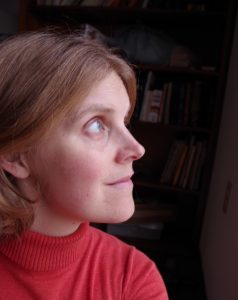 A former marine biologist, Lionel Davoust has been active in the French SF&F field for over 15 years. A magazine editor, anthologist, translator, podcaster, and electronic musician, he is above all a writer, with 30 short stories and 7 books under his belt, several awards, and many nominations. With his series about the planet Évanégyre, he is building an ambitious depiction of the evolutions of a fantasy world through the millennia, and his series “Léviathan,” an urban fantasy thriller, was featured on national TV and press.
A former marine biologist, Lionel Davoust has been active in the French SF&F field for over 15 years. A magazine editor, anthologist, translator, podcaster, and electronic musician, he is above all a writer, with 30 short stories and 7 books under his belt, several awards, and many nominations. With his series about the planet Évanégyre, he is building an ambitious depiction of the evolutions of a fantasy world through the millennia, and his series “Léviathan,” an urban fantasy thriller, was featured on national TV and press.
 Since college, Janice Friend has worked as a translator for asylum seekers, a biochemist, a fixer of software, and a professor. She lives in rural Virginia, where she also gardens, child-wrangles, and reads voraciously.
Since college, Janice Friend has worked as a translator for asylum seekers, a biochemist, a fixer of software, and a professor. She lives in rural Virginia, where she also gardens, child-wrangles, and reads voraciously.
“No One Really Knows” by Lionel Davoust, translated by Janice Friend
Nowhere is it said what became of the marionette after it was transformed into a little boy. We wonder or we imagine; perhaps we write our own pictures or patterns into the story. We suppose that – one of his dreams – the child went to school; we see him leaving the house the first day, satchel on his back, caught between misery and excitement. He makes some friends, or he is kept at a distance by those who cannot accept that he was once a puppet; his teacher takes him under her wing while he adapts; he works diligently on his homework at the kitchen table, under the admiring eye of his father, the artisan. See how quickly the years pass; he goes from elementary school to middle school; he discovers basketball, which he struggles to play because of the old stiffness in his joints; he throws himself into the usual competitions of adolescents, who are like young wolves heedlessly running in the shadows. He struggles in mathematics, applies himself to the recorder and, if he remembers to bring the correct notebooks, from then on he does his homework in his room upstairs, under the watchful gaze of rock stars. He feels a strange kinship with the instruments and the wood of the stage, more than with the musicians.
But he has no time for self-examination, because it is already time for high school. When the story ends, when the good fairy grants his wish, no one imagines that one day, string and wood would awkwardly invite a girl to the movies, and endure a rejection, then a second, a third. The stiffness of the adolescent grows like so: he braces himself against the jeers of idiots but he walks like a man wounded in the trenches and, with stiff legs and bent back, girds himself in his weakness and wears it as an armor of difference and scorn. No, no one imagines that one day, the darling puppet and its innocent questions could defy the rules laid down by a loving father and return in the middle of the night, reeking of alcohol, swollen with bitter pride, his heart full of glances the girls dart at anyone but him.
It is now the artisan who works at the kitchen table, doing the accounts for his workshop, trying to wring the most from a tax reduction so that he will not be forced to license his young apprentice. The cricket has long since left the marionette’s ear; the boy received with his flesh-and-blood heart free-will, the burden of morality, and the soft pain of dissatisfaction.
When the fable reaches its end, it does not follow the path of the puppet reborn; the child is left, paradoxically inarticulate, on his way to a beginning which we hope will be radiant. We do not imagine the young man alone, fleeing the sun’s heat, a sketch pad under his arm, hiding a too-fast and little-understood childhood behind a pair of mirrored sunglasses. The story does not tell us that this apprentice artist has forgotten why he handles wood pencils with such innate skill. The tale draws a veil over the place he will find in this world – but perhaps the adult shifts the flesh that he never wished to tame, as one tows a wreck, as a challenge thrown against passing time.
And when he finally notices that his supposed equals have ceased their mockery, to turn inwards, when he realizes that his raging challenges launched at the skies return only timid, indifferent rain showers, he at last accepts the affection of a young musician who caresses her cello and bow with an innocence in which he had no longer believed. She is at his side, holding his hand, as they mutely contemplate his father the artisan in a hospital bed, victim of a stroke brought on by his punishing work schedule. She is there to hold him when he weeps silent tears of wax, the day the shining coffin closes forever over the marionette-maker.
The tale also does not explain how the young, pretty cellist only loves, under her fingers, the singing wood of her instrument, and not the hardened flesh of a man limping under the weight of his isolation and displacement. She tires of searching for a crack in his armor, and leaves the artist for a banker who certainly only uses pencils for the household accounts, but who offers the comforting certainty of always eating the same breakfast cereal and always wearing a grey suit.
The tale which was told held within it the potential for hope; no one would say that this stiff, calcified man, rusted at the joints, was once a naive marionette with big blue eyes, who had everything to learn. No one could pretend that he was not welcomed in his difference, that he did not know how to keep the freshness of a new love, quieting little by little into kindness as old age came along. No one, not even the little boy, would know how to tell if the good fairy opened up the infinite paths of existence for him, or if she placed him on a route which he followed blindly, without turning back, walking alongside a banker who was soft, and smiling, and a lover of cereal.
No, the story does not explain what becomes of the puppet once he understands his isolation, with neither an artisan to shape him nor a cellist to feel the wood vibrate. It does not tell how the aging man one day re-opens his father’s workshop and meticulously sculpts a wooden mask to cover his tattered flesh; that he patiently fashions a shining brown carapace to fit around his torso and limbs. The cricket and the good fairy would have paid no attention to his savage howling when, with a fascinated slowness, he nails each piece to his dying flesh.
Because a children’s story could not end with the exit of a man who stands proudly under the rays of twilight, robed in a shining armor blackened with blood, like a terrifying and formidable obsidian golem. If he did not still have his supple, confident step, he could be mistaken for an immense marionette; but there is one last detail the puppet lacks. The strings are absent – except for one, hanging like a dead appendage, its end cleanly cut, rooted in his chest on the left side.
First published in Ténèbres, special issue, Dreampress (2007).
